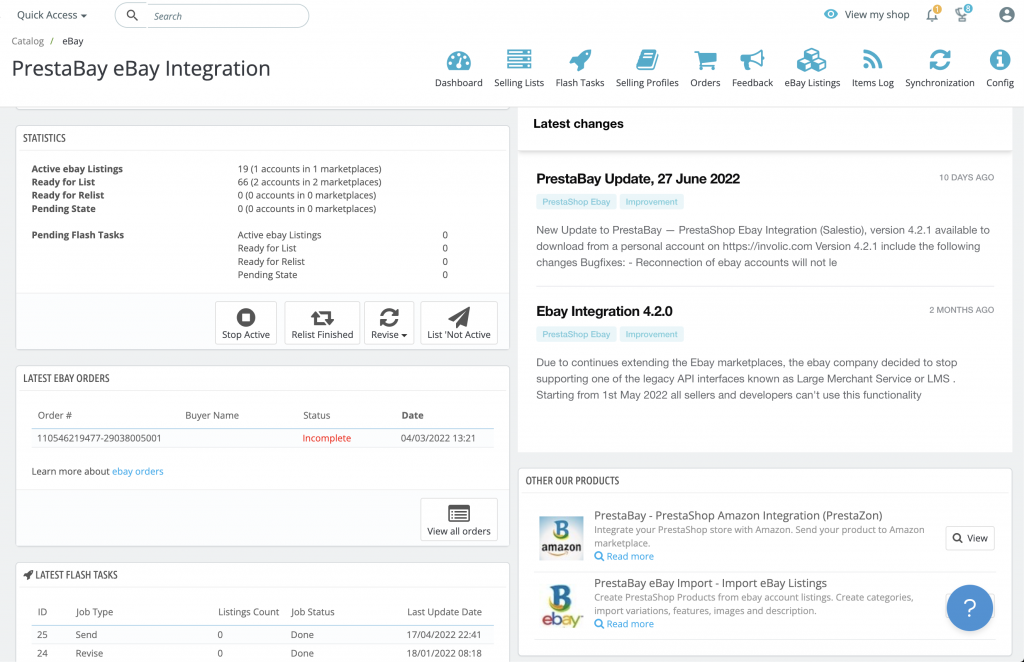07 Jul'22

Starting your e-commerce business for most is associated with the development of a website that will work as an e-shop. That is quite natural yet you shouldn’t limit your business just to this sales channel as there are pretty many opportunities to scale your business up using, for example, marketplaces.
eBay is no doubt one of the most powerful e-commerce platforms today. Yet some business owners consider it a daunting task to keep both the eBay store and e-commerce website. Let’s discuss the specifics of eBay sales and methods on how to integrate two profitable sales channels – eBay and the online store you have.
Specifics of eBay Sales
Starting your business on eBay is not as complex a task as you think about it. It may require time, as you need to file all the products in the catalog and maintain this catalog keeping in mind all the accounting routines. Yet the functionality of the platform is wide enough to create a real e-shop on it. Besides, eBay is the second marketplace in the world by the number of customer visits. Monthly, over 800 million users’ entrances are tracked on eBay. You should agree, it is a huge number.
To create an account for selling products on eBay, you need just to register and add your PayPal or Payoneer account. Besides, you need to pass a 3-month probation period to achieve the status of a trusted seller. One more specific feature of the eBay marketplace is the rating system that ranges all the traders and customers. Getting a good rate on eBay is even more important than providing an impeccable design for your store or creating a unique communication manner with customers.
Adding to this, keeping an eBay store can be challenging when you have also a website where you sell your products. These challenges include keeping synchronized accounting for the correct accounting for stock balances, the number of goods sold, and profits received
The Need for eBay Integration and Tools on How to Do This
At this point, we come to an important question. How to integrate your online store with an eBay store? Before, such an opportunity seemed to be something complicated and expensive. Initially, after the buyout of the eBay platform by the PrestaShop e-commerce site developer, the opportunity to create a single ecosystem for accounting sales was provided to those who used Prestashop directly to create their e-shop. Over time, add-ons for integration with eBay appeared in other trading frameworks. But some of them remained unfinished, and some were available in a full-featured version only on a paid basis. Today, one of the most logical and complete ways to integrate e-commerce sites with eBay is considered to be the tools of such a web tool for online stores as PrestaShop.
In particular, PrestaBay’s eBay Marketplace Integration Module is optimal in its simplicity and logic.
Working with this module allows you to get all the opportunities you need for successful work on both the PrestaShop e-store and eBay including the following features:
- Fast creating an eBay account for your web store.
- Sending Selling Profile and Selling List information to eBay.
- Real-time tracking orders and keeping an accounting of stock balances.
- Reporting on your sales both for the PrestaShop e-shop and eBay.
That’s just a peak of an iceberg as you can define the most important features for your business within that list.
How to Integrate your PrestaShop Web Store With eBay
Let’s take the example of PrestaBay’s Module we’ve mentioned earlier to describe how the integration on eBay works.

- Upload the module right in your admin panel in PrestaShop’s menu of your e-shop. Choose the point Modules for this.
- Install the module following the intuitive interface and notifications of the platform.
- Give the Module Configuration page access to eBay (Catalog-eBay point).
- Add your account on eBay to PrestaBay.
- Create both a Selling Profile and a Selling List.
- Send that information to eBay.
That’s all! After the confirmation from eBay, you can start working in an environment where your website’s sales and eBay orders are synchronized. That makes your business both more profitable as you gain more audience from eBay and simpler as you do not need to account for all the products and sales manually on two separated platforms. Hoping that article will inspire you to add an eBay store to your selling channels’ list.

Do you have any additional questions? Please reach us via email at support@salest.io





